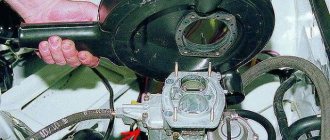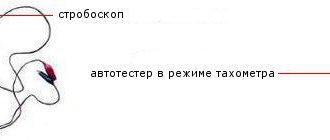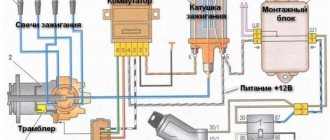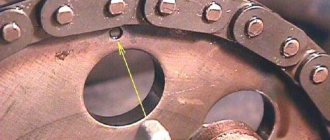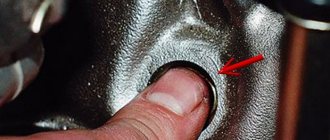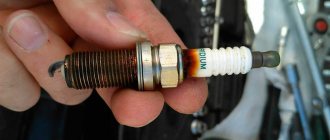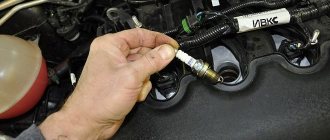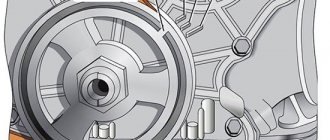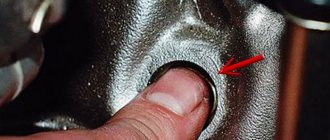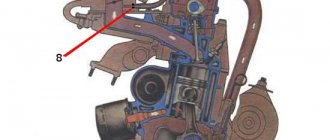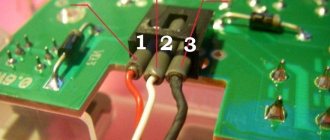Over the several years of production of the 2114 model, two types of ignition were installed on the car - contactless and electronic. If there are no problems with the second type, then with a contactless system there are problems. When there are problems with starting the engine and the stability of its operation, it will be useful to know how to set the ignition on a VAZ 2114. First, you need to know the differences between the two spark supply systems, and then carry out the repair yourself.
Useful video:
Injector types
The injector controls fuel injection and can also control the ignition. On all new injection machines, the ignition is set by a computer and regulated by filling in different firmware. But this was not always the case, and on older cars, the same Japanese from the 90s, the computer regulates only fuel injection, and the ignition timing is set using a distributor and is set in the same way as on old Lada models, and depending on the speed The ignition timing is adjusted using a more complex vacuum system than on carburetor Zhigulis. Sometimes, one tube breaks, and during operating mode the traction may disappear; you will have to look for and correct this defect.
But let’s return to more modern ignition systems that are controlled using a computer, especially since these were the ones that were originally installed on the injection VAZ.
Causes of malfunction
There are quite a few reasons why omissions may occur, namely:
Different compression in different cylinders. This is one of the most common reasons why misfires occur during engine operation, so you should check it first;
faulty spark plugs. There may be a number of reasons for this - from the resulting carbon deposits to the actual bad spark plugs. To solve the problem, you can try to restore (for example, clean) existing spark plugs or completely replace them with new ones;
An important rule to remember here is that you should always replace a complete set of spark plugs (4 pieces), even if only one is faulty. There is no need to skimp on engine performance
wear of armored wires or their breakage. Despite the high protection of high-voltage wires, during the operation of the vehicle they also wear out - their outer sheath becomes thinner and even breakdowns may occur. In order to check the condition of the armored wires, you should measure their resistance using a megohmmeter and compare it with the number indicated on the shell. If they are approximately the same, then the wires are in good condition, if not, then they should be replaced with new ones of a similar type;
- faulty electrical contacts. So, if misfires are observed in the 4th cylinder of a VAZ 2114, then it is worth checking all the contacts used to connect electrical equipment to this cylinder. If there are oxides or other contaminants, the contacts should be wiped with kerosene and cleaned with fine sandpaper;
- incorrect operation of the gas distribution mechanism. In order to detect it, you should inspect the timing belt and determine whether the marks of the upper and lower points coincide. If they match, then the mechanism is working properly, but if not, then they should be combined (in this case, it is highly advisable to replace the drive belt itself). When installing the belt, one should not forget about its correct tension - it is one of the main conditions for the correct operation of the gas distribution mechanism;
- failure of the ignition module. Despite its high reliability, the module can still break, as a result of which normal operation of the ignition system becomes impossible. You can determine its performance either for external reasons - by the presence of mechanical damage or deep corrosion, or by replacing it with a new one and checking the operation of the engine. If it turns out that the ignition module is damaged, then only replacement can help, since it is almost impossible to repair it;
- use of low quality gasoline. Of course, no car enthusiast will deliberately pour bad fuel into the tank of his car. But today's realities are such that the quality of gasoline sold at gas stations does not always correspond to what is declared. The use of such fuel first leads to clogging of the filters, and then of the injectors, as a result of which the normal injection of the mixture into the cylinders stops and misfires begin. You can avoid such a nuisance by using only proven fuel stations;
air entry. Excess air sucked into the system leads to a lean mixture and engine malfunctions. In order to find the place of its penetration, you will have to inspect the entire air intake system and check the condition of the o-rings.
Thus, the list of possible causes is quite large, and they should be checked sequentially, starting with the most probable. You shouldn’t put off troubleshooting “until later”, because running the engine with misfires can lead to very serious damage over time.
Ignition system sensors and marks
For the ignition system to operate correctly, the computer needs to read the correct information from the sensors. Subsequently, this information will be processed in accordance with the fuel maps hardwired into the injector.
The main signal comes from the crankshaft sensor. This sensor shows what position the crankshaft is in at a given time and, based on it, calculates at what moment it is necessary to inject fuel, and at what moment this same fuel should be ignited, depending on the engine speed, which is also determined by this sensor.
1 – crankshaft drive disc; 2 – crankshaft position sensor; 3 – angle of rotation of the crankshaft; 4 – output signal of the crankshaft position sensor
And this is what a typical signal received by a computer from the crankshaft sensor looks like. Pay attention to 270° - this is like the zero point, showing the computer that the engine has completed a revolution and a new cycle begins. This is achieved due to the absence of a tooth on the crankshaft drive sprocket.
Causes of ignition problems
As mentioned earlier, in order to set the ignition in the electronic system you will have to go into the “brains”, there you can also check the functionality of the sensors, so they greatly influence the operation of the system, regardless of the type of ignition.
On the electronic type, the main causes of failures are:
- Incorrect information transmitted from sensors to the ECU. If the connection to the brain and diagnostics showed strange data coming from one or more control devices, it is necessary to use a “substitution”. The easiest way is to find a car with known good sensors, install them and double-check the results. Here you need to understand that you do not need a new one, but a working sensor, because factory defects are not excluded even on a new mechanism.
- The incoming voltage - correct from a technical point of view is 5V, but if due to a violation of the mechanical integrity of the wires or another problem with the car’s electronics, this voltage changes, the sensor readings will also change after it. If this happens, the ECU begins to adjust engine operation based on incorrect data, which leads to incorrect operation of the entire mechanism as a whole. To check this breakdown, you will need a known-good system of wires leading to the sensor or a donor car into which you can install your sensor and test the system for functionality.
- Broken ECU - if the previous two options did not give a visible result, and installing your sensor and wiring in a working machine does not change its performance, only this option remains. You can try to reflash the “brain” of the car, but due to its low cost, it is better to immediately buy a new ECU and install it on the car.
Before moving on to the radical measures proposed in the third option, it is worth additionally checking the correct location of the labels. In cars with contactless ignition, this is the ignition installation of the VAZ 2114, and for cars with an electronic system, debugging is important to check the synchronization of the injection system with the gas distribution mechanism.
Ignition control
Electronic ignition control
How to set the ignition angle? On systems with electronic ignition control systems, this can be done using computer diagnostics that connect to the Electronic Control Unit (ECU) or the “brains” of the car. And there you can see how the engine operates in real time - what signals are received from the sensors, what engine speed, fuel consumption, injection timing, ignition timing and other input and output data.
Basically, you don’t need to change anything during operation unless you change the firmware. That is, if the machine somehow began to work incorrectly, then most likely there could be several reasons:
- An incorrect signal is received from the sensors; in this case, you can replace the supposed faulty sensor with a replacement one that is known to be working, and see if the result changes.
- The voltage in the network is incorrect and, accordingly, the sensors give the wrong signal. The input signal to the sensor is 5V, if this indicator is different, the ECU will receive incorrect input data and the engine will not be able to operate normally.
- The ECU is faulty. Quite often it happens that after going through everything possible, it turns out that your brains have flown. But don’t worry, they are inexpensive at VAZ.
Therefore, as such, the ignition is not set on injection machines, it is already built into the system, but it is worth checking whether the marks are set correctly.
Adjusting the ignition marks on the VAZ-2110 injector
When the engine is running, there are some phases that must work synchronously, the camshaft must coincide with the crankshaft, and the timing of fuel injection and ignition must correlate with them. Let's look at all this using the example of the VAZ-2110.
How to set the ignition on a VAZ 2110 injector
If the car doesn't start, it shoots, sneezes and everything goes wrong - the marks are not set somewhere and you need to sort it out.
On any car, the timing marks must be set perfectly, only then it will work normally. On the VAZ-2110, the crankshaft mark is located on the flywheel. You need to look through the inspection window on the gearbox housing; you can see the flywheel through it. It’s better to illuminate it with a flashlight, because it’s so easy to see.
The marks must match exactly. But... This may not happen. The fact is that when disassembling the engine, the flywheel can be placed on the other side, and then no one will need these marks. Let's consider other methods of how to deal with such a situation. To be honest, I have never set the timing belt to a mark on the flywheel; I don’t like this method.
A similar mark is present on the front belt pulley. Two points must coincide - one on the toothed pulley, and the second on the oil pump. If they coincide, it means that the pistons are at TDC of the 1st and 4th cylinders, and the crankshaft is set to its original position. It remains to do the same with the camshaft.
On single-shaft heads VAZ-2114, 2108, 2110, it is necessary to combine the boss on the sprocket and the protrusion on the rear timing belt cover.
For twin-shaft 16-valve engines, which are found on the VAZ-2112, the diagram looks a little different, the marks on the sprockets of both camshafts should look clearly upward, there are corresponding marks on the back cover with which they should coincide.
If all the marks match, great, the timing belt is ideal. Now all that remains is to check whether the crankshaft sensor is set correctly.
The crankshaft position sensor on the VAZ-2110 is installed in the front part of the engine; it reads readings from the sprocket, which is mounted on the pulley. This asterisk is placed on the key. And there are a few things to check here.
Since the pulley is placed on a key, a situation is possible when this seat breaks and the pulley is installed at a different angle, slightly turned out. From here, an incorrect signal will be sent to the crankshaft sensor, earlier or later than expected, and accordingly, the ignition will occur at an unknown time. It will be necessary to align the broken pulley more precisely, or change it along with the key.
Another problem may be that the crankshaft position sensor may be located too far from the pulley sprocket (maybe the sensor is slightly non-standard, or incorrectly installed), in which case the signal will be received incorrectly.
Useful video
You can find interesting information by watching the additional video below: https://www.youtube.com/watch?v=pNyBny-_HoQ
On a car with contactless ignition, everything is even easier; you don’t have to remove the wheels, but you will need an assistant. It is necessary to find the compression stroke of the fourth cylinder. To do this, insert a rubber cone into the spark plug hole and turn the ratchet. Pushing out the cone will mean that the compression stroke has been found.
Having illuminated the spark plug hole, we align the longest mark of the cover with the mark of the pulley. We set the breaker to the appropriate clock and check the operation of the system according to the fourth point described above.
The second Samara became the first car among VAZ front-wheel drive vehicles with an injection power system initially. The first copies of the VAZ-2114 were still going on sale with an eight-cylinder injection engine and a contactless ignition system, and the following engines already had a fully electronic system with the same 8 valves. Before you set the ignition, you need to find out what system is installed on the engine, which is what we will do now.
How to make injector ignition earlier
Almost half a century has passed since the first time a car equipped with a gasoline injection system rolled off the production line. Currently, the production of such machines has increased tenfold compared to carburetor models.
A person who is going to buy a modern car will most likely become the owner of a car with an injection-type gasoline engine. That is why the ability to configure the ignition on an injector is useful to many motorists.
Before you get started, you need to take care of the tools that you will need to adjust the ignition angle. Among them:
• screwdrivers; • a set of keys; • tester; • a laptop on which a special program is installed, designed for diagnosing injection-type engines.
Setting the ignition on the injector
As you know, the vehicle injector is controlled by electronics, which are subordinate to the car’s on-board computer. The first thing to do is to monitor the timely connection of all system components. To carry out this check, you must turn on the ignition. At this moment, the characteristic sounds of activation of the electric fuel pump should be heard, which begins to pump fuel into itself. If this does not happen, you need to check the relay responsible for the operation of the pump.
If a fault light appears on the instrument panel, diagnostics must be carried out. To do this, you will need a laptop with special software that connects to the car’s on-board computer to search and analyze errors. Thanks to the joint work of these devices, the car owner has the opportunity to explore all the available parameters.
You can proceed to starting the machine if no problems are detected in the functioning of the power unit at this stage. Now the throttle assembly is checked: a visual inspection of the condition of the sensor responsible for the correct position of the throttle valve, as well as the wires coming from it, is carried out. If, in your opinion, everything is in order, turn on the ignition and this time make sure that the sensor is working properly using a tester. It checks the voltage of the on-board network and the sensor itself. In this case, pay attention to the degree of throttle opening. The results obtained can only be compared with the nominal values indicated in the vehicle operation and repair manual. It should be remembered that the normal sensor voltage is a value in the range of 0.45–0.55 Volts. As for the on-board network voltage, it must exceed 12 Volts, while the degree of throttle opening should be no more than one percent. In case of deviations from these indicators, it is necessary to adjust the throttle drive so that it closes the damper completely.
After this, you should press the accelerator pedal until it stops and measure the parameters of the unit in this position. The throttle opening should be at least 90%, and the sensor voltage should be approximately 4.5 Volts. The throttle actuator may need to be adjusted if it does not open fully. The next step is to adjust the throttle actuator to achieve complete closure of the hole. To do this, the additional air flow regulator is turned off, the throttle must be set to the half-open position. In this state, the throttle assembly is adjusted so that the valve completely closes the hole.
Early and late ignition
Late ignition manifests itself in the behavior of the car by deteriorating engine response. This happens because the combustible mixture simply does not have time to burn until the moment the piston approaches the top dead center position. When the ignition is set late, the combustion process continues during the downward movement of the piston, which is accompanied by increased heating of the exhaust manifold. Early ignition also leads to a decrease in the engine's power capabilities, since the mixture is ignited at a time when the piston has not yet reached top dead center. In this case, the pressure of the expanding gases creates resistance to the movement of the piston element.
Note! Signs of early ignition are overheating of the power unit, detonation, and the appearance of black smoke from the exhaust pipe.
If you notice the slightest deviations in the operation of your car's engine, which are similar to those described above, most likely the ignition system requires more correct adjustment.
Having learned how to set the ignition on an injector, you can begin setting it up yourself, armed with the necessary set of tools. If you do not have enough time at your disposal to carry out this procedure on your own, or if you are not confident that you can cope with the task, you can entrust this work to specialists by taking your car to a trusted car service center. One way or another, it is not recommended to turn a blind eye to an incorrectly set ignition on your car, because the operation of the power unit in this mode can lead in the near future to even greater problems that can cause serious malfunctions, the elimination of which will require significant funds and time. That is why it is important to carefully monitor the condition of your personal transport, checking its main components and assemblies for serviceability, and timely carry out all the necessary preventive procedures.
Note! An incorrectly set ignition timing negatively affects such indicators of the car engine as efficiency, power and stability of its operation. Therefore, you should understand how important it is to properly configure this unit.
Long gone are the days when the world's first car rolled off the assembly line. It was equipped with a new injection system. The production of these machines today has increased 10-20 times. As you understand, we are talking about cars with injection systems. Let's find out how to set the ignition timing on the injector.
Today, 80 percent of people become owners of just such cars. Therefore, the ability to configure the ignition system is regarded as a very important advantage. It will allow you to always stay on the move, saving money on repair services and fuel.
Features of ignition settings in a carburetor engine
Setting the ignition according to the marks on a carburetor engine is carried out in exactly the same way as on an eight-valve injection engine. The only difference is the need to manually adjust the ignition angle. In a service station environment, this is done using a strobe light and tachometer.
- Raise the hood and use a wrench to loosen the three nuts holding the ignition distributor cap to the body.
- We scroll the lid so that the mark on it coincides with the “zero” mark on the housing scale.
- We start the engine and warm it up to operating temperature.
- Scroll the cap clockwise until the engine begins to produce the maximum number of revolutions. After that, turn it half a division to the left.
- We get behind the wheel and accelerate the car to 60-70 km/h in 4th gear. We press the gas pedal sharply down and listen to the engine. If there is a persistent detonation (fingers knocking) - we have too early ignition. We stop and turn the lid a little more counterclockwise. With the ignition angle set correctly, when we press on the gas, detonation should last no more than 2 seconds, after which the engine, having picked up speed, continues to operate normally.
- Having achieved the desired result, tighten the cover nuts.
Tools and Diagnostics
ATTENTION! A completely simple way to reduce fuel consumption has been found! Don't believe me? An auto mechanic with 15 years of experience also didn’t believe it until he tried it. And now he saves 35,000 rubles a year on gasoline! Read more"
Tools are an important part of any job. They will be needed to make adjustments to the process of issuing SOP. Mandatory tools include screwdrivers, a measuring instrument, wrenches, and preferably a laptop with a specially installed program designed for diagnosing injection-type power units.
VAZ-2114 ignition module: various signs of malfunction
The VAZ-2114 ignition module is also called a high-voltage coil, which serves to transmit current to the spark plugs. This module has its own signs of malfunction, by which it is necessary to determine when to replace the failed part. What are these signs? This will be discussed in this article.
Experts note the main symptom of a faulty ignition coil is the absence of an igniting spark on the spark plugs. But, besides this, there are other signs by which one can judge that the module has failed:
- Lack of dynamics during engine acceleration.
- The appearance of failures in the operation of a car engine at the moment of sharply pressing the gas pedal with your foot so that the vehicle accelerates.
- A noticeable decrease in engine power (as they say, “the engine doesn’t pull”).
- “Swimming” of idle speed.
When the first signs of a malfunction of the described module appear, the owner of the VAZ-2114 should diagnose it. This can be done either independently at home or at the nearest service center for repairing cars of this model.
The malfunction of this system can be judged by the following signs. Firstly, failures in the vehicle when accelerating can indicate coil malfunctions. Secondly, this can manifest itself in a significant loss of machine power, as well as in “floating” engine idle speed. And thirdly, incorrect operation is indicated by non-working cylinders 1-4 or 2-3.
It should be noted that such symptoms very often occur due to a faulty mass air flow sensor or idle air regulator. Therefore, first of all, we look at their performance, and only then we diagnose the ignition module.
Appearance of the standard ignition module
The ignition module in a VAZ 2114 car is an improved starting system. The device produces cycles that produce a spark - the engine starts. The ignition module creates high voltage current and then transmits it to the spark plugs through four high voltage wires. Among motorists, the device is called an “ignition system coil.” The electrical network of the VAZ 2114 powers the module, its “minus” is attached to the car body. It consists of:
- Ignition coils;
- Small plastic case;
- Electronic units;
- High voltage transformers;
- Outputs for connection.
The signal is transmitted to the electronics by the controller, which processes data on the functioning of the VAZ 2114 systems. The controller reads data from the sensors and then sets a certain sequence. The ignition coil is highly resistant to temperatures; withstands temperatures from -40 to 130 degrees Celsius.
Determining that a module has malfunctions is not so difficult. One of the signs is a decrease in engine power of the VAZ 2114 or acceleration in jerks. If the unit malfunctions, the engine begins to operate intermittently when idling. If such “symptoms” are present, then it is necessary to check the serviceability of the spark plugs and the fastening of high-voltage wires, as malfunctions may appear due to these elements.
Checking the VAZ 2114 for malfunctions must be carried out in compliance with safety precautions: hands must be wearing rubber gloves, and tools must be isolated. If the spark plugs and wires are in perfect order, the module needs to be replaced. You can find it under the hood; the device will reveal itself as large high-voltage circuits, from which replacement begins.
The module is quite easy to get, as there are minimal fastenings on it
In order not to make a mistake with connecting the wires when replacing, it is advisable to plug the high-voltage wires into their sockets and then label each of them. Then the new ignition coil can be connected, following the wires from the old one. Modern units have numbering that will help you figure out the connection. Marking will be useful if you buy an old-style module without numbering on the outputs.
Engine compartment of VAZ 2114
Before setting the ignition on the VAZ, let's look at the reasons why multiple misfires occur:
- Problems with spark plugs. Spark plugs will not be able to work normally and transmit a spark if there is carbon deposits on their electrodes, or if the gap in them has increased or decreased. As a rule, on a VAZ 2114 with an engine, the injector spark plugs fail as a result of the fact that low-quality parts were initially installed.
- Malfunctions in the electrical circuit. As a rule, we are talking about wear and tear on the wiring, chafing, and mechanical damage. In some cases, this problem can be solved by replacing the wires.
- Poor contact. During the operation of the car, the contact itself may oxidize, become covered with traces of motor fluid, or burn out. If possible, the functionality of the contact can be restored by cleaning or replacing. The last option is preferable, as it is practical.
- Incorrect operation or damage to the coil. If your car is equipped with a 1.6 liter injector, then it uses a coil. If this element breaks or does not work correctly, it can lead to the formation of gaps. It should be noted right away that there is no point in repairing the coils, since you cannot be sure of their performance. Therefore, if this part breaks, it will need to be replaced.
- Quite often, problems with the ignition system in injectors are caused by the use of low-quality fuel. Of course, if the cost of fuel is too low, this should be alarming, since such gas stations usually offer low-quality fuel. Due to the use of such fuel, the quality of the combustible mixture will also be low, in addition, cheap gasoline clogs filters and can clog injector nozzles. Accordingly, over time this can lead to the formation of gaps. The best option in this case would be to completely eliminate the malfunction and then use only high-quality fuel. Although its cost will be higher, you can be sure of the real quality of gasoline. Moreover, the money saved from using cheap fuel will in any case be used to repair the car, but it is quite possible that you will have to pay much more for this.
- Poor compression in the cylinders of the power unit. Compression should be checked first, as it can tell a lot of things. You can learn more about how to measure compression in a car from this material.
- Incorrect adjustment of the gas distribution mechanism is also one of the main causes of malfunction. If setting the timing belt does not cause big problems and does not take much time, this task can be accomplished on your own.
- Excess air entering the fuel system. This problem usually manifests itself as a result of existing damage to the intake manifold. In addition, it can be caused by wear on the elbows on the injectors and many other defects. In this case, we would recommend first diagnosing the tightness of the system in order to find possible places through which air can enter it.
- Another reason is that the gap between the cylinder and the piston has decreased significantly. In this case, there can be many reasons for the malfunction, however, you will have to check them in any case. First of all, you need to take into account that during engine operation, the piston ring grooves, special holes for the pin, etc. may wear out. In addition, the reason may lie in regular overheating of the engine, incorrectly adjusted rubbing and moving elements. In some cases, the malfunction is due to misalignment of the power unit, the use of low-quality motor fluid, and antifreeze getting into the oil. The latter problem is usually the result of a blown head gasket. In any case, all these malfunctions can lead to the appearance of a gap that does not meet the standards (the author of the video is the KV Avtoservis channel).
Ignition: late and early
Which ignition is better? An experienced motorist or expert will immediately say: optimal. And in itself, late or earlier ignition is already extreme, capable of giving the car owner a lot of headaches.
The stability of the operation of an injection engine directly depends on proper adjustment of the ignition system. This will help increase the power of the internal combustion engine, reduce fuel consumption, and improve efficiency.
Ideally, on a 4-stroke internal combustion engine, the fuel assembly should ignite at the end of the compression stroke. This means that the fuel must ignite at the very moment when the piston reaches TDC. This process is due to the nuance that the fuel assembly needs a specific time to burn, after which the resulting force will push the piston down.
So, late or early ignition implies a delay or advance in the operation of the above process. In other words, the ignition system is configured so that a spark is formed and ignites the fuel assembly not at the optimal moment for this. This happens sooner or later.
It is not difficult to determine if the ignition setting is not optimal. Engine malfunctions observed periodically are evidence of this. You can also study the main signs that determine an incorrectly set ignition.
- If there is unstable operation of the power unit in idling mode.
- Starting the internal combustion engine is clearly difficult.
- Fuel consumption has increased.
- The responsiveness of the accelerator pedal is not as impressive as before.
- The engine often overheats and detonation occurs.
- The power of the power unit decreases, it loses throttle response.
In addition, an incorrectly set OZ leads to popping noises that radiate into the intake system. Further operation of a vehicle with a crooked OZ is impractical and leads to more serious problems with the power unit. This is especially dangerous if detonation is noticeable.
| Symptoms and signs of pre-ignition | Symptoms and signs of late ignition |
| Excessive detonation (piston defect, destruction of connecting rods). | Loss of power. |
| A clearly audible knocking sound in the engine (increased wear). | Poor starting (which causes the battery to suffer). |
| Loss of power (especially noticeable at low speeds). | Increased fuel consumption. |
| Increased fuel consumption. | Engine overheating (may even seize). |
The difficulty of determining ignition on fuel-injected internal combustion engines is due to the fact that everything depends on the electronics. In this case, the problem must be solved not by mechanical intervention, but by configuring and programming the ECU.
It is noteworthy that on used cars, various errors accumulate in the ECU memory over time. The latter can lead to firmware failures and improper functioning of the engine and ignition systems. To identify and reset detected errors, you will need, as mentioned above, to use special software.
Consequences of incorrectly setting timing marks
If the ignition is set incorrectly, the following negative aspects are possible:
- If the engine has 16 valves, then they become deformed or bent during operation, accumulating damage.
- The previous problem causes damage to the cylinder head.
- The guide bushings may also become unusable.
- Cracks may appear in other engine components.
Crack in the cylinder block
- The motor overheats.
- The engine piston mechanism can burn out.
- Oil residue may appear on the spark plugs.
Oil deposits on spark plugs
The fuel mixture loses its ignition moment.
After repairs, the following factors most often indicate an incorrectly set ignition:
- The car accelerates worse.
- Frequent overheating of the motor.
- The craving became much worse.
Exhibiting UOZ on your own
The magnitude of the SOP depends directly on the amplitude of rotation of the crank shaft. The higher the rotation speed, the earlier the SOP should be set. Otherwise, there will be a decrease in power, overheating and premature failure of the internal combustion engine.
So, work begins with preparing the keys and indicator. Some experts also recommend acquiring a special OZ corrector, which allows you to set this characteristic automatically.
- The car should be put in neutral and the handbrake should be applied;
- remove the cover from the breaker;
- use a special wrench to turn the crank shaft until the marks on the cover and the shaft pulley match;
- connect the indicator at one end to the ignition module, at the other end to the ground of the power unit;
- loosen the breaker fastening;
- turn on the ignition;
- hold the distributor slider against the stroke and turn the breaker until the indicator goes out;
- turn the distributor a little more, and then return it to the original exposure and record it at the very moment the indicator lights up.
A VR or vacuum regulator is introduced into the system in order to automate the adjustment of the SOP as much as possible. The VR independently changes the angle, depending on a particular load.
For example, if the power unit operates in the XX mode, the VU regulator turns the distributor disk towards late ignition. And vice versa, as soon as the load increases, a vacuum occurs, the VR turns the distributor back.
In principle, on a modern fuel-injected car the system is automatically adjusted. However, situations are not uncommon when the factory settings are lost, and the OZ has to be set manually. But in any case, and any specialist will confirm this, you must first make sure that such adjustment is necessary.
Forget about fines from cameras! An absolutely legal new product - Traffic Police Camera Jammer, hides your license plates from the cameras that are installed in all cities. More details at the link.
- Absolutely legal (Article 12.2);
- Hides from photo and video recording;
- Suitable for all cars;
- Works through the cigarette lighter connector;
- Does not cause interference to radios and cell phones.
Common faults
Diagnostic program There are several reasons why the phenomenon of misfires in the ignition system occurs on the VAZ 2114.
- Problem candles. If carbon deposits appear on them, the gap decreases or increases, they will not be able to work properly. As a result, there are misfires in the cylinders. Quite often, spark plugs do not work for the simple reason that the car owner decided to save money and buy spark plugs of dubious quality. You should not count on their long service life and reliable operation.
- Wiring problems. Here you most often have to deal with wire wear, chafing, and mechanical damage. Sometimes the problem is solved by replacing the wiring. But in some cases, wiring can negatively affect the functionality of the devices it goes to. As a result, both the wiring and the device must be replaced.
- Contacts. Contacts may burn out, become covered in oil, or rust. Cleaning them or completely replacing them may help. The second option is preferable in order to reduce the risk of omissions occurring after a short period of time.
- Damage to the ignition coil or module. If you have a VAZ 2114 with a 1.6-liter engine, you are dealing with a coil. Owners of the newer version with a 1.5-liter engine are already solving problems with the ignition module. Regardless of this, units often fail and cause leaks. There is no point in repairing them, so it is better to immediately replace them with new ones.
- Use of low-grade fuel. The problem for many owners of domestic cars is that they, sometimes unknowingly, doom themselves to constant repair work. A trivial example is the use of cheap gas stations. Low-quality gasoline produces a poor air-fuel mixture, clogs filters, and clogs injectors. This often causes misfires in the cylinders. The right solution is to fix the problem and start using good gas stations. Their gasoline is more expensive, but you will spend many times more money on repairs if you don’t stop refueling with God knows what.
- Omissions. They also often occur due to impaired compression in the cylinders. This fault should be checked almost first.
- The gas distribution mechanism is not adjusted correctly. Its adjustment will not take much time; the work can be done with your own hands.
- Excess air enters the fuel system. This may occur due to damage to the intake manifold, wear of the rings on the injectors and other defects. Therefore, you should check the system for leaks and find sources of air intake.
- The gap between the piston and cylinder has decreased. There may be many reasons for this, but you will definitely have to check them if this is the reason.
The essence of eliminating cylinder misfires is to step-by-step check the causes of malfunctions. It could be anything from the list presented, or something rarer. That is why it is better to entrust the work to specialists, since it will take a lot of time to independently check each component of the fuel system and ignition system. Moreover, it is not a fact that you will eventually find the reason for the engine malfunction.
Injector types
The injector controls fuel injection and can also control the ignition. On all new injection machines, the ignition is set by a computer and regulated by filling in different firmware. But this was not always the case, and on older cars, the same Japanese from the 90s, the computer regulates only fuel injection, and the ignition timing is set using a distributor and is set in the same way as on old Lada models, and depending on the speed The ignition timing is adjusted using a more complex vacuum system than on carburetor Zhigulis. Sometimes, one tube breaks, and during operating mode the traction may disappear; you will have to look for and correct this defect.
But let’s return to more modern ignition systems that are controlled using a computer, especially since these were the ones that were originally installed on the injection VAZ.
Ignition setting guide
One of the reasons is an incorrectly set ignition timing. To ensure that this problem no longer bothers you, you need to set this parameter - this can be done either with your own hands or at a service station. The crankshaft pulley has a special toothed disk designed to generate electromagnetic vibrations. Subsequently, the sensor converts these vibrations into a signal transmitted to the control unit. The latter, taking into account these parameters, in particular the position of the crankshaft, transmits an impulse to the module that distributes the spark between the spark plugs.
So, how to set the ignition yourself:
- First, remove the protective plastic cover from the timing device. Check the gap between the controller and the toothed disk - ideally it should be no more than 0.7 mm. If the gap is larger, this will result in a weak signal from the controller to the control unit.
- If the gap is normal, you need to start placing marks, but first you need to look at their compliance with the standard. This will allow you to ensure that the pulley on the crankshaft is not misaligned, otherwise the controller will also send incorrect information to the block. The mark on the flywheel must be aligned with the mark located on the transmission housing. To do this, the unit has a hatch where two risks are marked. In order for the marks to be aligned, it is necessary to rotate the crankshaft.
- The second mark is located on the oil pump pulley; you need to ensure that it coincides with the so-called tide on the cylinder block.
- As for the third mark, it is located on the camshaft drive gear pulley. It must be combined with the boss on the cylinder head, that is, the cover of the timing belt.
Ignition system sensors and marks
For the ignition system to operate correctly, the computer needs to read the correct information from the sensors. Subsequently, this information will be processed in accordance with the fuel maps hardwired into the injector.
The main signal comes from the crankshaft sensor. This sensor shows what position the crankshaft is in at a given time and, based on it, calculates at what moment it is necessary to inject fuel, and at what moment this same fuel should be ignited, depending on the engine speed, which is also determined by this sensor.
1 – crankshaft drive disc; 2 – crankshaft position sensor; 3 – angle of rotation of the crankshaft; 4 – output signal of the crankshaft position sensor
And this is what a typical signal received by a computer from the crankshaft sensor looks like. Pay attention to 270° - this is like the zero point, showing the computer that the engine has completed a revolution and a new cycle begins. This is achieved due to the absence of a tooth on the crankshaft drive sprocket.
Checking completed actions
To diagnose the actions performed, you will need pliers, a standard tool and a tester (multimeter). High voltage wires can be checked with a multimeter. Normal wire resistance is from 5 kOhm to 12 kOhm.
At this stage, we will perform diagnostics of circuits, and not microprocessor elements. To check the latter, you will need specialized equipment and experience, which we do not have.
So, how is the check done:
- First you need to turn off the ignition and diagnose the contacts on all plugs and pads. It is also necessary to diagnose the tightness of the fit, as well as the contact of the high voltages in the module.
- Next, remove the block from the module and diagnose the voltage at terminals C and B. In this case, the tester must be configured in the mode for measuring low alternating current.
- Check the high voltages. To do this, you need to install a working spark plug in the cap and attach it to the block head. At this point, your assistant should try to start the engine by turning the starter. If the wire is working, then a spark will jump between the spark plug and the block head. Thus, it is necessary to diagnose all wires.
- In the event that there is no spark on only one cable, it is necessary to thoroughly diagnose the module itself, but in most cases the device must be replaced. If everything works correctly, the spark plugs are working properly, but there are still problems with the engine, you need to check the power system.
Almost all modifications of the VAZ-2114 and 2115 are equipped with engines with BSZ (non-contact electronic ignition). To make the setup, you need to:
- Unscrew the timing case fasteners and remove it.
- Adjust the gap from the crankshaft sensor (located near the generator pulley) to the gear disk. The permissible value is up to 0.7 mm.
- If the distance is normal, check that the crankshaft pulley is not misaligned.
- To ensure that the marks on the flywheel align with those on the gearbox housing (can be seen on the hatch), the crankshaft must be rotated. It is convenient to do this by grasping the pulley mounting bolt.
Note! It is prohibited to turn the camshaft pulley itself.
- The mark on the cylinder block must align with that on the oil pump pulley. They should be adjusted.
- The last mark (on the camshaft pulley) should coincide with the other mark on the cylinder head.
Having placed the marks on the VAZ model, you can see that the pistons of cylinders 1 and 4 are located at the dead center at the top, if everything is done correctly. In this case, the power unit operates correctly because the crankshaft sensor sends correct data to the ECU.
Ignition control
Electronic ignition control
How to set the ignition angle? On systems with electronic ignition control systems, this can be done using computer diagnostics that connect to the Electronic Control Unit (ECU) or the “brains” of the car. And there you can see how the engine operates in real time - what signals are received from the sensors, what engine speed, fuel consumption, injection timing, ignition timing and other input and output data.
Basically, you don’t need to change anything during operation unless you change the firmware. That is, if the machine somehow began to work incorrectly, then most likely there could be several reasons:
- An incorrect signal is received from the sensors; in this case, you can replace the supposed faulty sensor with a replacement one that is known to be working, and see if the result changes.
- The voltage in the network is incorrect and, accordingly, the sensors give the wrong signal. The input signal to the sensor is 5V, if this indicator is different, the ECU will receive incorrect input data and the engine will not be able to operate normally.
- The ECU is faulty. Quite often it happens that after going through everything possible, it turns out that your brains have flown. But don’t worry, they are inexpensive at VAZ.
Therefore, as such, the ignition is not set on injection machines, it is already built into the system, but it is worth checking whether the marks are set correctly.
Adjusting the ignition marks on the VAZ-2110 injector
When the engine is running, there are some phases that must work synchronously, the camshaft must coincide with the crankshaft, and the timing of fuel injection and ignition must correlate with them. Let's look at all this using the example of the VAZ-2110.
Getting ready to adjust the ignition
In order to correctly set the ignition timing of the VAZ 2114 and carry out debugging, you need to prepare. The method described below does not require acrobatic agility from the owner and is quite feasible both in the uncomfortable and cramped environment of a garage and if the car enthusiast has a tummy.
IMPORTANT! Thorough preparation always speeds up the process of technical work significantly, regardless of what exactly needs to be repaired.
Preparation for debugging ignition marks is carried out as follows:
- The car is placed on a flat surface and placed on the handbrake.
- The second step is to remove the front right wheel, which will subsequently allow you to gain access to the gas distribution mechanism itself, which will speed up the work, make it convenient and easy, for this: a. unscrew the fastenings of our wheel and place a wheel chock under the diagonally opposite wheel (rear left); b. We lift the car with a jack, twist the wheel mounts completely and remove it.
- Finally, we need to remove the timing belt splash guard (if there is one, of course). By the way, you can not remove it entirely, but just unscrew the two lower fasteners, then it can be moved away without damaging it.
